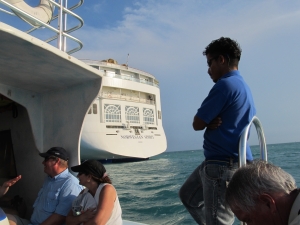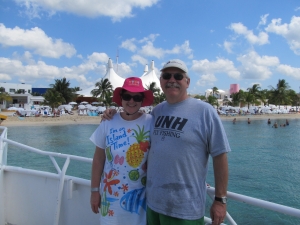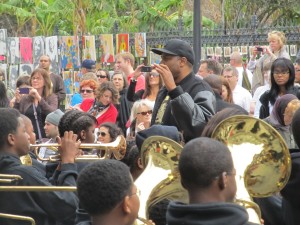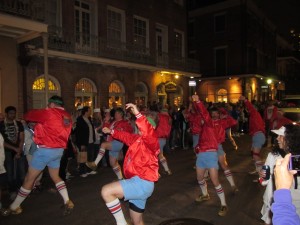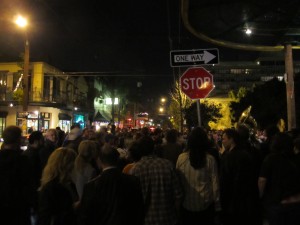In 2007, the seond year I traveled to New Orleans during spring break, the students and I stayed at Camp Hope, a former elementary school that housed volunteers in St. Bernard Parish. It was in the town of Violet, about 20 miles from New Orleans. The drive back and forth seemed long when done late at night, but it was pleasant during the day time. That is, once you had numbed yourslf to the abandoned neighborhoods, refinery and chemical spills, and still evident destruction in the low-lying parish.
And, for thre first time in nearly 20 years, it meant my wife and I were both in New Orleans at the same time. Which was great, mind you; however, my wife saw first-hand the New Orleans mania that I have developed over the years. In spite of uncontrolled, Rain Man-like recitations of New Orleans trivia, some memorable things happened before our disembarkation. Chiefly, after a Sunday morning walk through the residential part of the French Quarter, we attended mass at St. Augustine’s in Treme, the oldest, African-American, Roman Catholic parish in the United States. The mass was built around a jazz band, a bluesy choir, a charismatic priest, and a joyful, welcoming congregation. And in the midst of Lent, it was a welcome reminder that religion is about praise and joy and not sack cloth and ashes. After and hour and a half, we had to skip out early to make sure we checked out of hotel in time.
As a result, we were among the first on board, seated and having lunch just an hour after leaving mass. After a week of running around between work sites and trips from Slidell into New Orleans, it was relaxing to take in the City from 12 stories up. At 5:00 p.m. we set saiil and began the seven to eight h9ur trip down the river to th Gulf. I got to see the French Quarter, the Bywater, the Lower Ninth, and the Jackson Barracks, where during Katrina, military trucks and material was rendered useless by flooding. And from my high perch, I saw the length of the Chalmette Battlefield, where in 1815, Andrew Jackson defeated the most seasoned army in the world; hundreds of British and Scottish dead at a cost of but seven Americans from a ragtag, multicultural army of frontiersmen, pirates, native Americans, and free Creoles of color. And right next door, the site of Camp Premier, the FEMA camp where I stayed in March 2006 (named for the company who provided the tents and folding cots, likely owned by a well-connected campaign contributor). Beyond that: the refineries whose flooding rendered entire neighborhoods unlivable; that tract of grazing land, more beautiful than I remembered; the shrimping community of Violet; and the modern, rebuilt school that once housed volunteers as Camp Hope.
The trip down memory lane devolved into hours of marsh and river bends. Over the flat expanse, the New Orleans skyline receded ever so slowly into the distance. I was on deck late that night as we cleared the river’s mouth, entering the oil and gas fields of the Louisiana Gulf.
It was a good week of seeing the sites and people watching and I didn’t obsess too much of how much things I saw were like or unlike New Orleans. The food was good and, with some care, not as fattening as what I would have consumed in New Orleans. The music was definitely worse. While there was some good music to be heard on land, I am amazed at how many different versions of “Sweet Caroline” one can hear on shipboard. And the greater cosmic question: if Bob Marley never existed, would the band by the pool just stand around, silent? That is, until they replay the calypso version of “Sweet Caroline.”
Among some other things I noticed: on shore, in the Western Caribbean, time is relative, much like in New Orleans; we may think that the number of smokers has declined, but half of those remaining were on our cruise (the other half are in the bars of New Orleans); and why do people on cruise ships paw through merchandise on sales tables? Wouldn’t they ignore the same stuff if it were in the window of a shop, in say, Lafayette or Little Rock (examples picked totally at random)? And finally, why do so many people on cruises, especially Southern women of a certain age (not to get too specific here) spend most of their time looking as though someone has been force-feeding them pickled buzzard eggs? My suspicion, given that they can afford to go on a cruise, is that their lives don’t totally suck. And even if they did suck, wouldn’t walking around on a boat, with people throwing food at you, stopping in warm, exotic ports where friendly people live, cause you to force a smile or two? Just saying.
Well, we had fun. No pickled buzzard eggs for us. Yeah, we lost a little money in the casino. We pretty much ignored the on board entertainment, except for various versions of “Sweet Caroline.” We enjoyed kind of dressing up and having leisurely meals in the dining room, frequently discussing our daily adventures with nearby diners. And as we sailed northward through the deep water oil rigs, our exhaustion should have been accompanied by a certain sadness. But we had beautiful weather and another day in New Orleans awaiting us.





